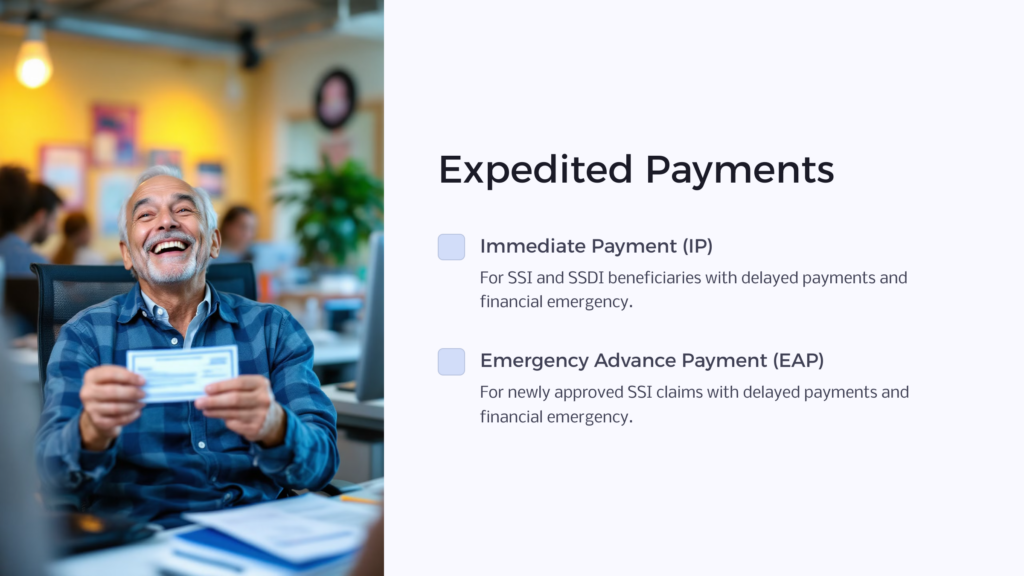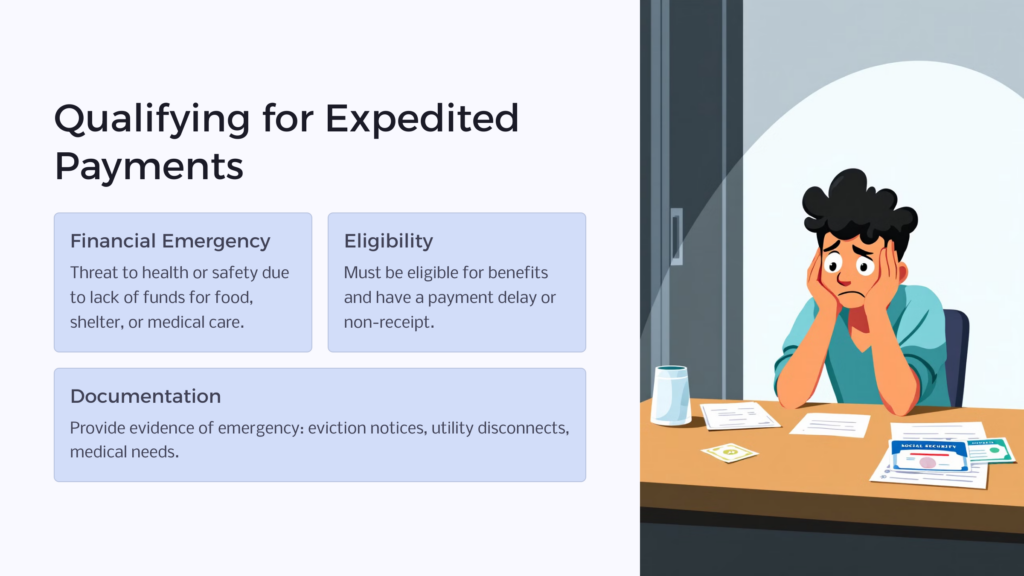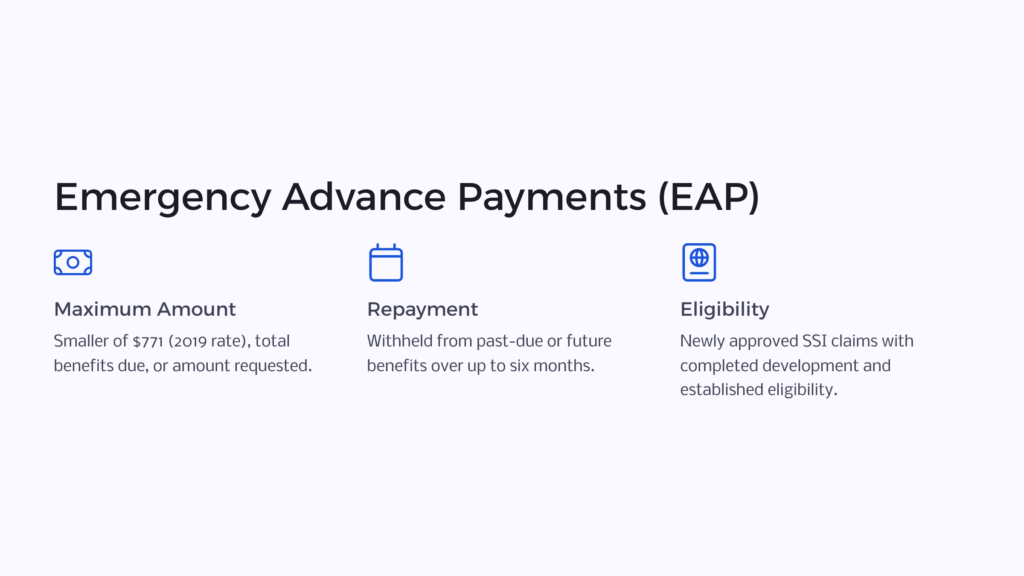How to Get Money When your SSI or SSDI Check or Direct Deposit Doesn’t Come
How to get payment when your benefits don’t come depends on whether the missing payment was due on a scheduled payment day or was a payment sent for delivery at another time and also on whether your benefits were paid directly to a bank account or DirectExpress debit card or in a paper check sent via the mail service.
If a missing payment was due on your regularly scheduled payment date, you must wait three business days before reporting a missing payment to the Social Security Administration (SSA). If the payment is not a regular monthly payment and you were told it was issued on a certain day, you must wait seven business days from the issue date to report non-receipt. Note that if your scheduled payment falls on a weekend or a holiday, your payment is to be delivered on the Friday before the weekend or the last business day before the holiday.
If your benefits were paid to a DirectExpress debit card or to an account at a bank, credit union, or brokerage, your first step is to contact DirectExpress or the financial institution where you have your account to check that the bank didn’t receive the funds. If they did receive the funds, request that they credit your account. If they did not, get a statement from the DirectExpress or the other financial institution that the funds were not received. Then submit that proof to Social Security when you report the non-receipt. When you report to SSA and provide a statement from the bank or DirectExpress that your benefits were not received and Social Security’s records show the money was sent to the correct account, SSA will immediately request a replacement payment, which will be available in your account or on your debit card within one to two business days.
If, however, the financial institution says that they returned the funds, the replacement payment will not be issued until the refund is processed through the banking system and SSA receives it. The refund processing usually takes three business days.
One circumstance in which funds might be returned by a bank is if you changed banks and closed your old account before your report of a new account was processed. (Tip: always keep an old account open until you receive benefits in your new account.)
If the payment was a paper check, SSA will place a stop payment on the original missing check. Once the stop payment has been processed, which can take up to ten days, a replacement check will be issued. In this circumstance, if the first original check shows up, you cannot cash the check. If in the past you reported a missing payment and then cashed both the original and the replacement, it may take as many as thirty days for you to receive payment.
In other circumstances, you may not have received payment because the payment was not issued. This will occur when information was needed from you or additional processing was required before the payment could be issued. Many different circumstances could cause a suspension of benefits. For example, perhaps you moved and didn’t notify Social Security, so they sent you notices for an SSI redetermination or a continuing disability review (CDR) that did not reach you because they were sent to your old address. As soon as the necessary information is received and/or required processing has been completed, benefits will be issued.
Getting Payment Faster in a Financial Emergency

Your local Social Security Administration (SSA) office has the authority to issue expedited payments in a same-day, direct payment if you are eligible for disability benefits, you have a financial dire need that qualifies as a “financial emergency” (defined later in this article) and payment has been delayed or is urgently needed before it can be issued by normal means. These checks cannot be mailed and will only be issued in the Social Security office to the person eligible for the payment or a representative payee if one has been appointed. The decision to issue a direct payment is up to SSA and you will not be given appeal rights if it is decided you are not eligible for a payment.
There are two kinds of expedited direct payments: an immediate payment (IP) and an Emergency Advance Payment (EAP). The difference between these two will be explained later in this article. The EAP can be paid to Supplemental Security Income (SSI) beneficiaries and the IP can be paid to either SSI beneficiaries or Social Security Disability (SSDI) beneficiaries.
To receive either of the expedited payments, you or your representative payee if you have one, will have to go into your local Social Security office to make the request because the payment, which is in check form, has to be handed to you. If approved the payment will be prepared in the office while you wait; or if there isn’t insufficient time left in the day to accomplish the payment, it may take until the next day.

It is best for you to go into your local office as early in the day as possible. This will ensure you have given the Social Security office enough time to prepare and authorize the checks. Each IP or EAP requires multiple people to issue it. One person takes the request, a member of management authorizes it, and a designated non-management employee prepares the check. This method ensures that no payments are improperly made, but this security method also means that it can take a few hours to get the expedited payment because any of the members of the expedited-payment team could be tied up providing service to another person when it is time for them to complete their step of the process. All this means that even if your request is approved, patience is required.
What is a “financial emergency”?
The test of financial emergency (called dire or urgent need in SSDI regulations) applies to both types of payments, IP and EAP. A financial emergency means you need money right away due to a threat to health or safety, such as not having enough money for food, clothing, shelter, or immediately needed medical care. An emergency can exist, even if you have liquid resources if you cannot access them quickly enough to meet your immediate threat to health or safety.
You do not need to provide Social Security with specific evidence that supports your allegation of financial emergency. However, if Social Security discovers evidence that contradicts your request, you may be required to provide proof of your situation. Even if this does not occur, submitting proof, if you have it, may help Social Security make a favorable decision on your request. Types of proof of need that you can provide include eviction notices, utility disconnect notices, proof of imminent foreclosure, physician statements or other proof of the immediate need for medication or other medical services, or whatever other evidence you have available that documents your situation.
Emergency Advance Payments for Newly Approved SSI Claims
 Emergency Advance Payments (EAPs) are made to people who meet all the following criteria: determined to be eligible for Supplemental Security Income (SSI) disability benefits, have not yet received any SSI benefits, have a financial emergency as defined by the Social Security Administration, and are due SSI benefits that have been delayed or paid but not received. It is important to note that before the an EAP can be issued, all development on your claim must be completed and your eligibility for payments established. Of equal note is that EAPs are only payable under the SSI program; EAPs are not available for Social Security Disability (SSD aka SSDI) benefits.
Emergency Advance Payments (EAPs) are made to people who meet all the following criteria: determined to be eligible for Supplemental Security Income (SSI) disability benefits, have not yet received any SSI benefits, have a financial emergency as defined by the Social Security Administration, and are due SSI benefits that have been delayed or paid but not received. It is important to note that before the an EAP can be issued, all development on your claim must be completed and your eligibility for payments established. Of equal note is that EAPs are only payable under the SSI program; EAPs are not available for Social Security Disability (SSD aka SSDI) benefits.

The maximum EAP you may receive is the smallest of the SSI Federal Benefit Rate, which in 2019 is $771, plus any federally administered state supplement; the total amount of benefits due at the time of the request, and the amount requested for the financial emergency.
An EAP is not extra money. The advance payment will be withheld from any past-due benefits. If you are not eligible for back pay, the advance payment will be deducted from your ongoing benefits spread over a period of up to six months. If you are determined to be ineligible for a payment, the EAP becomes a recoverable overpayment.
If you have appealed prior denials and are approved an appeal and receive an SSI EAP and then payment is delayed further, you may later apply for an Immediate Payment (IP), which is discussed below.
Emergency Advance Payments with Presumptive Disability
In a small percentage of claims, an individual can be so severely disabled that it is presumed that the person meets the Supplemental Security Income (SSI) medical requirements to receive benefits. The local Social Security office uses a listing of medical conditions to determine if a claimant qualifies for PD payments. You can review the listing at https://www.ssa.gov/ssi/text-expedite-ussi.htm, which shows the medical conditions that are considered when making a determination of presumptive disability. If the local office cannot make a PD decision but thinks that with a minimal medical review PD could be established, they will notify the Disability Determination Services (DDS) to see if a PD decision can be made.
Once a presumptive disability has been established, payments can be paid for up to six months while the claimant waits for the Disability Determination Services (DDS) to make a final decision. These payments including any made with an EAP are not considered overpayments, even if your claim is denied upon more complete investigation.
Usually, Emergency Advance Payments are issued after a medical approval has been finalized. However, EAPs can be made in the month you file your application if the local office or the DDS determines you are presumptively disabled and eligible for PD payments and you meet the other EAP criteria. The amount of the EAP will be based on the amount of SSI due to the following month. If you are applying for a small child who has been determined to be presumptively disabled and who do not yet have a Social Security number, no EAP can be issued until the child is issued a valid Social Security number.
Immediate Payments for Missing or Delayed SSI and SSDI Benefits
An Immediate Payment (IP) is different from an Emergency Advance Payment (EAP) in that it can be paid to someone who has already begun receiving SSI or Social Security Disability (SSDI) payments, not just to someone who is newly eligible for SSI. Another difference is that, if needed, more than one IP can be issued; although in most cases, thirty days must have passed before another IP can be issued. There are some exceptions when a second IP can be issued within thirty days, but they are rare.
An IP can be paid if your SSI or SSDI payment is delayed or the payment has been sent to you but you have not received the payment, the payment is due, and you have a financial emergency (dire need or urgent need) as described above.
The maximum amount an individual can receive in an IP is the smaller of $999.00, the amount you are due at the time the payment is issued (this includes any back pay you may be due), or the amount you requested for the financial emergency. If you are an eligible couple receiving SSI, each member can receive of the smaller of $999.00 or the amount of benefits you are due. If you are concurrently entitled to benefits (receiving benefits from both the SSI and SSDI programs), you may be eligible to receive a payment from both programs; however, the limits listed above apply to the combined amount released from both programs. Like EAPs, these IPs are not extra money and the full amount will be collected from your future payment at the time the payment is due.
Here are some examples: If you need and request $500.00 to pay your past due rent and you are due $1,000.00 in benefits, Social Security will issue a check for $500.00 and then collect it from the $1,000.00 you are due when the delayed payment is issued. If you need and request $1,200.00 to pay back rent and utilities that are disconnected and the total amount currently due you is $700.00, Social Security will issue a check for $700.00 and withhold next entire benefit of $700 to collect the IP. Here’s a third example: If you need and request $1,500.00 for back rent, utilities, and food and your back payment due is $2,000.00, Social Security will issue you a check for $999.99 and collect it the $999.99 from your $2,000.00 back pay resulting in a back payment of $1,001.
When Expedited Payment Is Denied
If you are part of a married couple living together, you both share the responsibility for meeting your financial need. This means that if your spouse has the ability to take care of your urgent need, your request for an EAP or IP will be denied. If your need can be met reasonably quick enough through other resources in the community, your request for an expedited payment may be denied. Lastly, an EAP or IP typically will not be issued if other corrective measures can be taken that will result in receipt of benefits the next business day, either deposited to your bank account or to a DirectExpress debit card, which is a method of electronic payment for individuals without bank accounts.
If the payment that you have not received is a Social Security benefit and a seven-day delivery will meet your urgent need, then payment will usually be made through the SSDI Critical Case system rather than an IP being issued.
Lastly, if you are receiving SSI or SSDI payments and your benefits were suspended and you now have provided the necessary information to have them reinstated by the local office, SSA can usually process your payment using normal procedures with the payment being sent to a financial institution or your DirectExpress card within a couple of days. Because electronic payments can be processed very quickly, Social Security will only issue IP payments on a very limited basis when the financial emergency is imminent.
 Benefits.com Advisors
Benefits.com Advisors
With expertise spanning local, state, and federal benefit programs, our team is dedicated to guiding individuals towards the perfect program tailored to their unique circumstances.
Rise to the top with Peak Benefits!
Join our Peak Benefits Newsletter for the latest news, resources, and offers on all things government benefits.




















